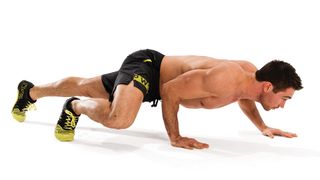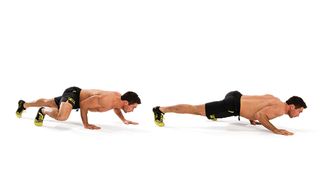Crocodile Walk Exercise: A Core Cruncher
Try this bodyweight move to build your core as well as strong abs, arms and legs

When detailing the best features of a crocodile, impressive core strength would probably not make your top five. But make no mistake, behind those terrifying teeth and limb-rending claws is a muscle-bound mid-section any fitness fiend would be proud of.
Mimicking the crocodile’s walk is thus an excellent way to strengthen your own core, and the movement is also especially taxing on the arms and shoulders. The crocodile walk is a combination of press-ups, the plank and crawling, so it targets a whole load of muscles at once.
RECOMMENDED: Core Exercises
The Benefits
The crocodile walk is a total-body workout that will improve your endurance, and build strength in your core, arms, legs and shoulders. Keep the movement slow and controlled for maximum benefits. That said, if you want to really go for it, a real crocodile can hit 11mph on land, so that’s something to shoot for.
How To Do It

- Start in a press-up position, with your legs and arms shoulder-width apart.
- Lower yourself down until your torso is as low as it would get during a press-up. You should aim to keep your upper body as low as possible throughout the exercise, bracing your core and glutes to ensure your posture is correct.
- Begin walking by bringing one knee up towards the elbow, simultaneously moving the opposite arm forward. Then repeat on the other side.
The croc crawl is surprisingly hard, so don’t set yourself too big a distance the first few times you try, instead aim to keep going slowly for 30 seconds (you can go backwards if you run out of room), before taking a break and trying again. It’ll get easier once you become accustomed to the technique, and then you can add it into circuit training.
Crocodiles are not the only animal whose perambulation is worth copying if you’re on a fitness kick. If the croc walk is proving too tricky, you can instead opt for the bear crawl. The premise is the same, crawling along on all fours, but you don’t have to get your torso so close to the ground, making it slightly easier on your upper body.

Get the Coach Newsletter
Sign up for workout ideas, training advice, reviews of the latest gear and more.

Nick Harris-Fry is a journalist who has been covering health and fitness since 2015. Nick is an avid runner, covering 70-110km a week, which gives him ample opportunity to test a wide range of running shoes and running gear. He is also the chief tester for fitness trackers and running watches, treadmills and exercise bikes, and workout headphones.
